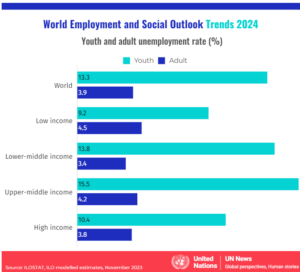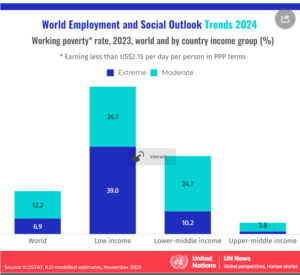A little over five per cent of the global workforce is currently unemployed, as outlined in the International Labour Organisation’s World Employment and Social Outlook Trends 2024 report. While this marks an improvement from the pre-pandemic era, the situation is anticipated to change, with an additional two million individuals expected to join looking for a job in the coming 12 months, according to the ILO.
The International Labour Organization’s (ILO) World Employment and Social Outlook Trends: 2024 (WESO Trends) report paints a complex picture of the global labour market. While the unemployment and jobs gap rates have improved and fallen below pre-pandemic levels, indicating a positive trend, the report reveals underlying fragility.

In 2023, the global unemployment rate modestly improved to 5.1 per cent, a slight drop from the 5.3 per cent recorded in 2022. The jobs gap rate and labour market participation rates also showed positive signs in 2023. However, the report projects a worrisome future for the labour market, anticipating a rise in global unemployment in 2024, with an additional two million workers expected to seek jobs, pushing the global unemployment rate to 5.2 per cent.
The decline in disposable incomes across most G20 countries raises concerns, particularly as the erosion of living standards due to inflation is expected to be a slow process to reverse. Notably, significant disparities persist between higher and lower-income countries, with higher job gaps and unemployment rates in the latter.
Working poverty remains a concern, with the number of workers living in extreme poverty increasing by approximately one million in 2023 despite a quick decline after 2020. Income inequality is rising, posing challenges to aggregate demand and a sustained economic recovery.
The report also highlights that rates of informal work are expected to remain stagnant, constituting around 58 per cent of the global workforce in 2024.

This prognosis aligns with recent insights from a newly published World Bank report on 10th January, revealing that the world economy is heading towards its slowest half-decade of growth in three decades.
Adding to the uncertainty in the job market outlook, the International Labour Organization (ILO) pointed out that many of the world’s wealthiest nations have witnessed a decline in living standards. This erosion is attributed to inflation, a concern currently subsiding in many major economies.
Let us delve into the detailed picture of the report.
Widening Disparities in Global Labour Markets
ILO experts highlight substantial disparities between higher and lower-income countries. In 2023, the jobs gap rate, representing the percentage of jobless individuals actively seeking employment, was 8.2 per cent in wealthier nations, contrasting sharply with the 20.5 per cent rate observed in poorer countries.
Likewise, the unemployment rates for the same year revealed a divergence, with wealthier countries experiencing a 4.5 per cent unemployment rate. In comparison, low-income countries faced a higher rate of 5.7 per cent.

ILO Director-General Gilbert Houngbo cautioned against the ramifications of this scenario, stating that “falling living standards and weak productivity, combined with persistent inflation, create the conditions for greater inequality and undermine efforts to achieve social justice.”
Emphasising the critical link between social justice and sustainable recovery, ILO Director-General Gilbert Houngbo stressed that achieving lasting economic revival necessitates addressing workforce challenges promptly and effectively.
Rising Extreme Poverty and Growing Inequality
Although the number of workers living in extreme poverty experienced a rapid decline post-2020, there was an unfortunate reversal in 2023, with an increase of about a million individuals earning less than US$2.15 per person per day.
The report further highlights a widening income inequality trend, with the erosion of real disposable income posing challenges for both aggregate demand and the prospects of a more sustained economic recovery.
Despite concerted policy initiatives addressing the informal economy, the number of people employed informally is anticipated to remain stagnant, making up approximately 58 per cent of the global workforce in 2024.
Lingering Shadows of the Pandemic
Although the World Health Organisation (WHO) officially ended the declaration of COVID-19 as a public health emergency last May, the enduring repercussions of the pandemic persist, as revealed by the ILO report.

For the approximately 20 per cent of individuals affected by ‘long COVID,’ lingering symptoms and health issues continue to impact productivity significantly. Those re-entering the labour market post-pandemic often work fewer hours, accompanied by a notable increase in sick days.
While women’s participation in the job market has rebounded swiftly, a conspicuous gender gap remains, particularly in emerging and developing nations. Youth unemployment rates remain a persistent challenge. Despite technological strides and increased investment, the report highlights a continued slowdown in productivity growth.












Comments 1